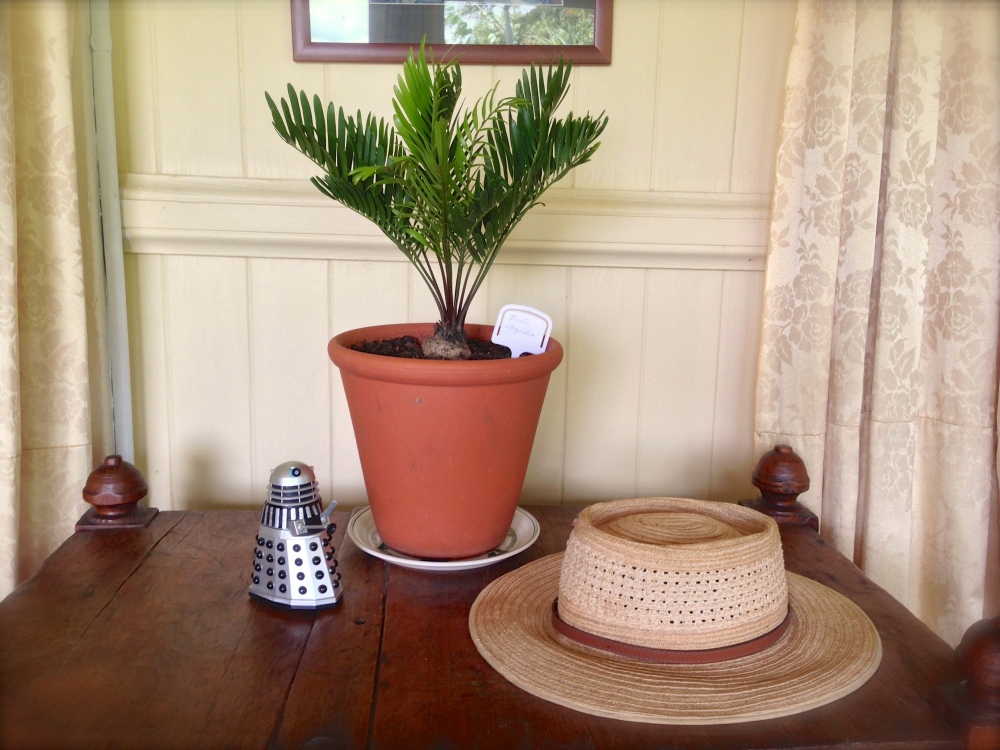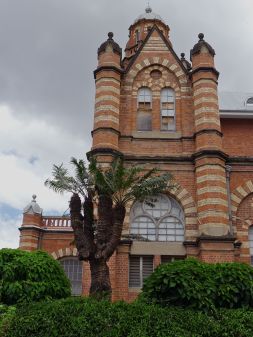
Q: “What’s a cycad?”
A: “Just over 300 species of cycad survive, many are only known as fossils. Think Tolkein, think Middle Earth, think dinosaur food. Wonderful plants, the kind you want to have with you always.”
Thanks to the Palm & Cycad Societies of Australia’s annual sale, (8-9.3.14, Brisbane), I am now the proud steward of a clutch of fine cycad seedlings.
You can’t really ‘own’ a cycad, but you can be a good steward. Like certain tortoises and parrots, happy cycads can outlive their carers. Cycads are special, almost from a parallel universe. Botanists currently believe they are most closely related to the Bennettitales, a plant line allied to conifers, that has been extinct in Australia for around 23 million years.
Pollen is transferred from male plants to females mainly by insects like beetles, bees, and sometimes by the wind. You can harvest pollen, store it in a bag in a deep freeze to keep it viable, so later you can pollenate a female cone. As I once did, saving pollen from my early coning male Encephalartos ferox with a neighbour who grows a later coning female specimen.
Old cycads store a lot of food, sufficient to last through a long, global meteor-strike winter. Of the 300 or so surviving cycad species, some predate dinosaurs, but most are post-Cretaceous, meaning they have evolved in less than 65 million years, some even more recently. (Homo sapiens, by comparison, evolved between 400,000 and 250,000 years ago).
Growing up into a big, starchy food reserve creates problems for an elder cycad. They are targets for hungry grazing animals. So they’ve armed themselves with nerve poisons, ‘borrowed’ from toxic bacteria living in their roots. Cycads employ these blue-green bacteria to convert atmospheric nitrogen into nitrate fertiliser, which they use. They developed coralloid roots to become their fertiliser factories. To further frustrate grazing animals, fresh, tender new fronds become harder than leather, just days after unfurling. To encourage herbivores to move along, some cycads carry armour-piercing spines that would bring tears to the eyes of any dinosaur, or the mammals which superseded them.
This morning I bought home-grown seedlings of Ceratozamia hildae (Mexico); Cycas debaoensis (China); Encephalartos kisambo (Kenya); E. natalensis (South Africa); Macrozamia communis (NSW); M. macleayi (Queensland); M. mountperriensis (Queensland); M. moorei (Queensland); Zamia muricata (Colombia & Venezuela), and Zamia picta (Guatemala & Mexico).
I just potted up my new Zamia integrifolia (USA, Caribbean, pictured). A crock over the drainage hole of a deep terracotta pot, the bottom third filled with cactus mix, the rest with premium-grade potting mix.
When I discovered that the genus Zamia is a critical food plant for the caterpillar of the Eumaeus butterfly, until recently believed extinct, I worked in some llama dung in the top layer. It deserves a fillip.
In July 2011, I recorded a segment with Gardening Australia demonstrating how to propagate a cycad by removing a stem bud. At the time I wondered if the cutting of a male Encephalartos natalensis would drop or keep its fronds, and how long it might take to develop roots. It quickly dropped its fronds.
A year later there were still no signs of any roots developing, but the stem bud seemed firm and healthy. So I took it out of its pot and pressed it into some compost rich soil in a warm, sunny and sheltered position by my coffee tree. It wasn’t until 30th October 2013 – twenty seven months later – the cutting developed roots and sprouted a whorl of eleven fronds, each half a metre long. Cycads do things in their own time.
Globally, many cycads are threatened by over collection from the wild, and by the loss of remaining habitat to farming and housing. So conserving the last remnants of wild cycad habitat is our duty.
I love buying cycad seedlings and watching them grow, it’s the beginning of a new friendship. I enjoy watching plants grow. I especially love observing these curious lifeforms, as they age they becoming increasingly intricate and individualistic.
Cycads are family plants. See how a carpet of coralloid roots rises through the mulch in autumn? They live in pulses: dramatic cones emerge as quickly as they unfold new whorls of fronds. Soft and delicate on the first day before they harden. I love baby Encephalartos ferox fronds, knowing how fierce they become with maturity.
When a cycad bursts into growth, it can be dramatic. Sometimes crowns increase by fifty percent in a fortnight. In Sydney, my Encephalartos natalensis rewarded consistent good care with two bursts of growth each year.
When a cycad starts producing a new flush of growth, maximise that growth by sprinkling some pelletised poultry manure around its base. I check the weather radar to make sure soaking rain in guaranteed to wash the manure in, helping to deodorise it. As a cycad ‘switches on’ a growth phase in dry weather, I give them a good soaking with seaweed solution. Established cycads have an amazingly intricate root system and it becomes very intimately woven into the mulch, ground and adjacent plant root systems. Very efficient.
It’s always a special occasion when a cycad matures and produces it first cones, revealing its gender. Give them perfect drainage, use a premium potting mix, mulch them with a modest layer of compost, and keep renewing this as it decays.
Pot them up each year. Water them so they don’t remain dry for too long – most are drought-tolerant – but don’t treat them like desert cacti. Given this basic care, most species are forgiving and many will outlive their stewards. I think of them as a lifelong investment and an inter-generational gift.
Fancy becoming a cycad steward? If so, please treat it with respect and care…
Jerry Coleby-Williams
8th March 2014

















































very interesting, greetings from Mexico. you have a nice colection too 🙂